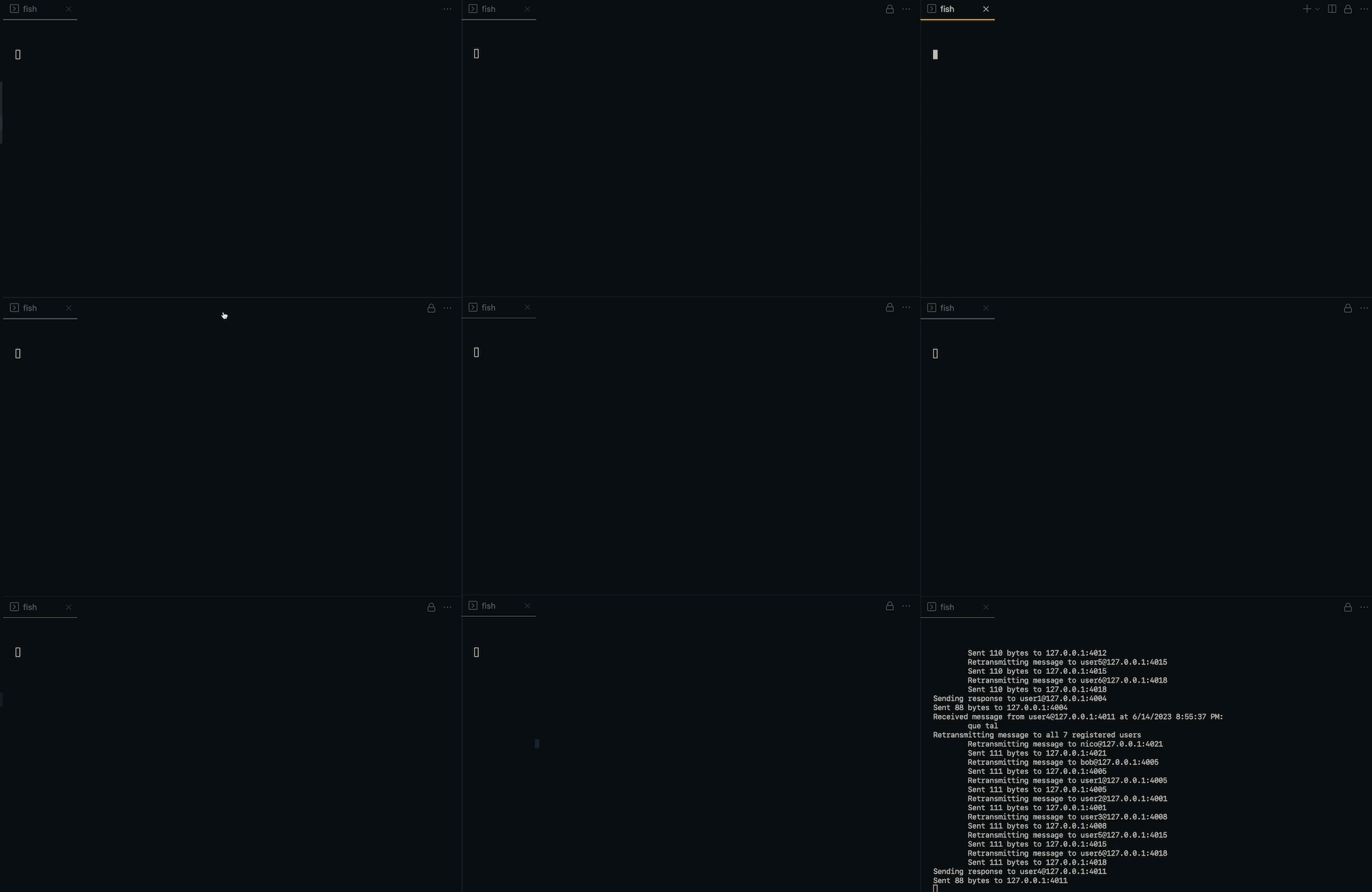UDP Multichat CLI Application
This chat app is a simple UDP client/server application that allows multiple clients to connect to a server and send messages to each other. The server is able to handle multiple clients at once and will broadcast messages to all connected clients.

Table of contents
Quickstart
To get the system started you must first start the server. This can be done by running the server CLI application. See Server CLI for more information.
Once you have a server clients can be started in order to interact with the server. See Client CLI for more information.
Design
Client CLI
The client CLI is a simple command line interface that allows the user to interact with the system.
Server CLI
The server CLI is a simple command line interface that allows the for creating a server in the system that can be used by clients in order to send messages to be retransmitted to other registered users.
Project structure
See Code Documentation for more information.
Messages between Client <-> Server | De/Serilization
Client and server interchange messages in the form of JSONs. The JSONs are deserialized into code usable class objects that represent the messages. Because the messages are serialized into JSONs they can be sent over the network and deserialized into the same class objects on the other side. This allows for easy communication between the client and the server.
A client must be logged in to send messages to the server. The server will then broadcast the message to all other registered users.
For more information about this see UdpChat.Server.ServerService
Authentication
The server has basic authentication with a user being able to:
- register
- login
- unregister
- logout
The user is able to send messages to the server. The server will then broadcast on the moment the message to all other users that are registered. Messaegs are not stored by the server, just retransmitted, hence if a user is not online and logged in they will not receive the messages they have missed.
For examples on how to use the client see Client CLI.
Persistence
Registered users are persisted into an SQLite3 database. This allows for the server to be restarted and still have the registered users. This allows for user login functionality. This also means that a username must be unique and not registered.
Concurrency model
This implementation does not use the typical get request -> explicitly spawn thread/process for request.
Instead it uses an asynchronous programming model. The UdpClient.BeginReceive method to start listening for incoming UDP datagrams from any client. This method is non-blocking and allows the program to continue execution while waiting for incoming messages.
When a message is received, asynchronous handlers are called (depending on which service receives the message). These methods handle incoming messages and perform operations based on the type of message received.
Furthermore, the processing of each incoming message (deserialization, request handling, etc.) is wrapped in a Task.Run call, which queues the specified work to run on the ThreadPool and returns a task handle for that work. This means that each message is processed in its own task, allowing for concurrent processing of multiple messages.
Also note that while UDP allows for the concurrent receipt of messages from multiple clients, it does not guarantee the delivery of messages (i.e., it's a connectionless protocol).
To know more about the specifics of the implementation see UdpChat.Server.CentralRetransmissionServer and UdpChat.Server.ServerService.
Basic functionality of a UDP Multichat
sequenceDiagram
participant Client
participant Server
participant OtherRegisteredClients
Client->>Server: Sends Authentication request
Server->>Client: Sends Authentication response
Client->>Server: Sends Message
Server->>OtherRegisteredClients: Broadcasts Message
Server->>Client: Sends Message Ack
Possible client states
sequenceDiagram
participant Client
participant Registered
participant NotRegistered
participant LoggedIn
participant NotLoggedIn
participant SendingMessage
participant ReceivingChatMessage
Client ->> Registered: Can be
Client ->> NotRegistered: Can be
Registered ->> LoggedIn: Logs in
NotLoggedIn ->> LoggedIn: Logs in
NotRegistered ->> Registered: Register
Registered ->> NotLoggedIn: Can be
LoggedIn ->> NotLoggedIn: Log out
LoggedIn ->> NotRegistered: Unregister
LoggedIn ->> SendingMessage: Sends a message
LoggedIn ->> ReceivingChatMessage: Receives a message retransmission from the server
Possible server states
sequenceDiagram
participant Server
participant ListeningForMessages
participant ListeningForAuthenticationRequests
participant AnsweringAuthenticationRequests
participant RetransmittingMessages
Server ->> ListeningForMessages: Can be
Server ->> ListeningForAuthenticationRequests: Can be
ListeningForMessages ->> RetransmittingMessages: Receieves a message from a client
ListeningForAuthenticationRequests ->> AnsweringAuthenticationRequests: Receives an authentication request from a client